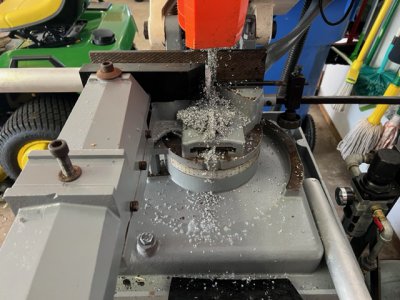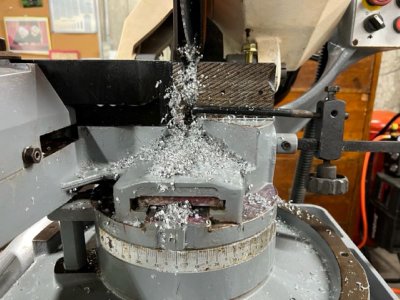I've got a cold saw but the chips just drop near the blade. Blade isn't turning fast enough to throw anything. Two speed motor. Makes beautiful cuts and is way faster than a bandsaw.yes, but they kick the swarf everywhere.
-
Welcome back Guest! Did you know you can mentor other members here at H-M? If not, please check out our Relaunch of Hobby Machinist Mentoring Program!
You are using an out of date browser. It may not display this or other websites correctly.
You should upgrade or use an alternative browser.
You should upgrade or use an alternative browser.
Band Saw Blades-Need your thoughts
- Thread starter Janderso
- Start date
- Joined
- Apr 14, 2014
- Messages
- 3,165
Mine is about the same. It's a variable speed machine with infinitely variable speeds from 21 rpm to 120 rpm. The blade doesn't turn fast enough to throw swarf, but if the coolant flow isn't right on the money it will pile up. Here are a few pictures I took when dialing in the machine. If I recall correctly the material was 2" 6061 aluminum round stock. The pictures are after cutting half a dozen slugs for measuring. The last picture is after I vacuumed off the machine, but no cleanup on the floor.
As you can see there is a pile of swarf on the machine, but little or none on the floor or surrounding area. I was able to get the slugs to within .001" of straight and parallel with just the right blade speed and down force. I wouldn't plan on getting them that close in a production situation, but .002" is certainly doable without too much effort.
As you can see there is a pile of swarf on the machine, but little or none on the floor or surrounding area. I was able to get the slugs to within .001" of straight and parallel with just the right blade speed and down force. I wouldn't plan on getting them that close in a production situation, but .002" is certainly doable without too much effort.
Attachments
- Joined
- Nov 25, 2015
- Messages
- 8,319
From that view, that's a nice looking shop. Looks pretty comfortable to work in.Mine is about the same. It's a variable speed machine with infinitely variable speeds from 21 rpm to 120 rpm. The blade doesn't turn fast enough to throw swarf, but if the coolant flow isn't right on the money it will pile up. Here are a few pictures I took when dialing in the machine. If I recall correctly the material was 2" 6061 aluminum round stock. The pictures are after cutting half a dozen slugs for measuring. The last picture is after I vacuumed off the machine, but no cleanup on the floor.
As you can see there is a pile of swarf on the machine, but little or none on the floor or surrounding area. I was able to get the slugs to within .001" of straight and parallel with just the right blade speed and down force. I wouldn't plan on getting them that close in a production situation, but .002" is certainly doable without too much effort.
- Joined
- Apr 14, 2014
- Messages
- 3,165
Thank you. The shop originally started in the garage. It only lasted a couple years due to the cold winters and warm springs. Even though the garage can be heated everything was lost when one of the doors were opened for more than a few minutes. On warm spring days the machines sweated so bad it was like being in a rainstorm.From that view, that's a nice looking shop. Looks pretty comfortable to work in.
I moved the machines I had at the time to my version of a "finished" basement and have continually added more over the years. It's a very comfortable 65* year-round with no humidity. Each machine had to be disassembled and carried down the stairs one piece at a time. There are now a couple dozen machines. I have a few more on the "wish list", but I'm running out of room.
The older lathe in the picture is what started it all. At the time I got it I was working in an experimental design machine shop. I made a few parts on it for work and that started the fire. I knew I would be retiring within a few years and the machines at work would no longer be accessible. I convinced my wife that this would be a good and fairly inexpensive hobby. The rest is history.
- Joined
- Mar 26, 2018
- Messages
- 8,408
Looks like a beautiful shop!!Thank you. The shop originally started in the garage. It only lasted a couple years due to the cold winters and warm springs. Even though the garage can be heated everything was lost when one of the doors were opened for more than a few minutes. On warm spring days the machines sweated so bad it was like being in a rainstorm.
I moved the machines I had at the time to my version of a "finished" basement and have continually added more over the years. It's a very comfortable 65* year-round with no humidity. Each machine had to be disassembled and carried down the stairs one piece at a time. There are now a couple dozen machines. I have a few more on the "wish list", but I'm running out of room.
The older lathe in the picture is what started it all. At the time I got it I was working in an experimental design machine shop. I made a few parts on it for work and that started the fire. I knew I would be retiring within a few years and the machines at work would no longer be accessible. I convinced my wife that this would be a good and fairly inexpensive hobby. The rest is history.
Many very nice shops are in basements.
Living in California we don't have them unfortunately. I don't know why??
- Joined
- Apr 14, 2014
- Messages
- 3,165
Forgive me father for I have sinned. Well, at least I broke the "rule of thumb" when cutting some material on my horizontal bandsaw. In the past I've generally tried to honor the (min 3 teeth/max 24 teeth) rule, with an occasional slip. This time I blatantly ignored it just to see what would happen. I had what I thought was a well-worn 10/14 pitch bimetal blade on the machine. I was pretty sure it was near the end of its life, and if I removed it I would in all probability I would never use it again.
I put it to the ultimate test cutting several pieces of 1/4" x 8" and 1/4" x 8-1/2" plate. The saw has a maximum vertical capacity of 7" so the material had to lay flat on the bed. It would be a real test of the machine in that I had to make a total of 10 cuts of either 8" or 8-1/2". So, at any one time I had between 99 and 103 teeth engaged in the material. I did cut at the lowest speed of 60 fpm and used stick lubricant on the blade.
Much to my surprise the machine cut the material with no problems. With light down pressure there was no clogging of the gullets, no broken teeth, and straight and true cuts. I must admit each cut took about 4 minutes. I was so impressed I decided to see if there was enough blade left for a few more cuts. This time I had to make 4 cuts on some 2"x 2" x 3/16 angle iron. Once again, I was surprised at the durability of the blade. It easily made straight and true cuts.
Perhaps my initial assessment of the blade was a bit premature. I'm not sure how much life is left in it after the abuse I gave it, but it's still on the machine. Next time around I'll see how things go. There can't be much life left after what I put it through.
I put it to the ultimate test cutting several pieces of 1/4" x 8" and 1/4" x 8-1/2" plate. The saw has a maximum vertical capacity of 7" so the material had to lay flat on the bed. It would be a real test of the machine in that I had to make a total of 10 cuts of either 8" or 8-1/2". So, at any one time I had between 99 and 103 teeth engaged in the material. I did cut at the lowest speed of 60 fpm and used stick lubricant on the blade.
Much to my surprise the machine cut the material with no problems. With light down pressure there was no clogging of the gullets, no broken teeth, and straight and true cuts. I must admit each cut took about 4 minutes. I was so impressed I decided to see if there was enough blade left for a few more cuts. This time I had to make 4 cuts on some 2"x 2" x 3/16 angle iron. Once again, I was surprised at the durability of the blade. It easily made straight and true cuts.
Perhaps my initial assessment of the blade was a bit premature. I'm not sure how much life is left in it after the abuse I gave it, but it's still on the machine. Next time around I'll see how things go. There can't be much life left after what I put it through.
- Joined
- Nov 25, 2015
- Messages
- 8,319
the max is not a hard max. The more important is the 3, since less can break teeth. with more teeth, you just slow the feed down so the chips can clear without over filling (packing) the gullets.
No surprise that you got through. Surprised you set the blade to the slowest speed... more speed, more clearing of chips, less time cutting for each tooth.
No surprise that you got through. Surprised you set the blade to the slowest speed... more speed, more clearing of chips, less time cutting for each tooth.
- Joined
- Apr 14, 2014
- Messages
- 3,165
I realize that 24 is not the hard max. However a 103 tooth engagement is more tha 4 times the “suggested” maximum. I think that’s more than a slight stretching of the number that should be engaged at one time
As for speed steel is always cut at a lower speed than softer materials like aluminum or plastics.
As for speed steel is always cut at a lower speed than softer materials like aluminum or plastics.
I routinely (and intentionally) violate the rules. And the saw cuts fine. For larger material I slow up the feed a bit. I find this works better for a ham-handed clod like myself that otherwise breaks perfectly good blades on sharp features when cutting extrusions. Even with a 10/14, I have to be careful, particularly cutting angle.
GsT
GsT
I don't change blades on my 4x6 Bandsaw no matter what I'm cutting. Don't change blade speed either, too lazy. I've never seen a chipped tooth, but never searched for them either. I will support the weight of the head by hand when fairly thin material is being cut. No Hydraulics on these machines. I cut everything that will fit, on the cold saw. Faster, smoother cut. I did make a slightly larger table for vertical use and can leave it on for horizontal use. The 4x6 is about 30 years old. The cold saw ?? but I'd guess 60+ years old from the long gone company name on it. The cold saw is setup with auto, pneumatic clamping and unclamping based on the position of the blade.





